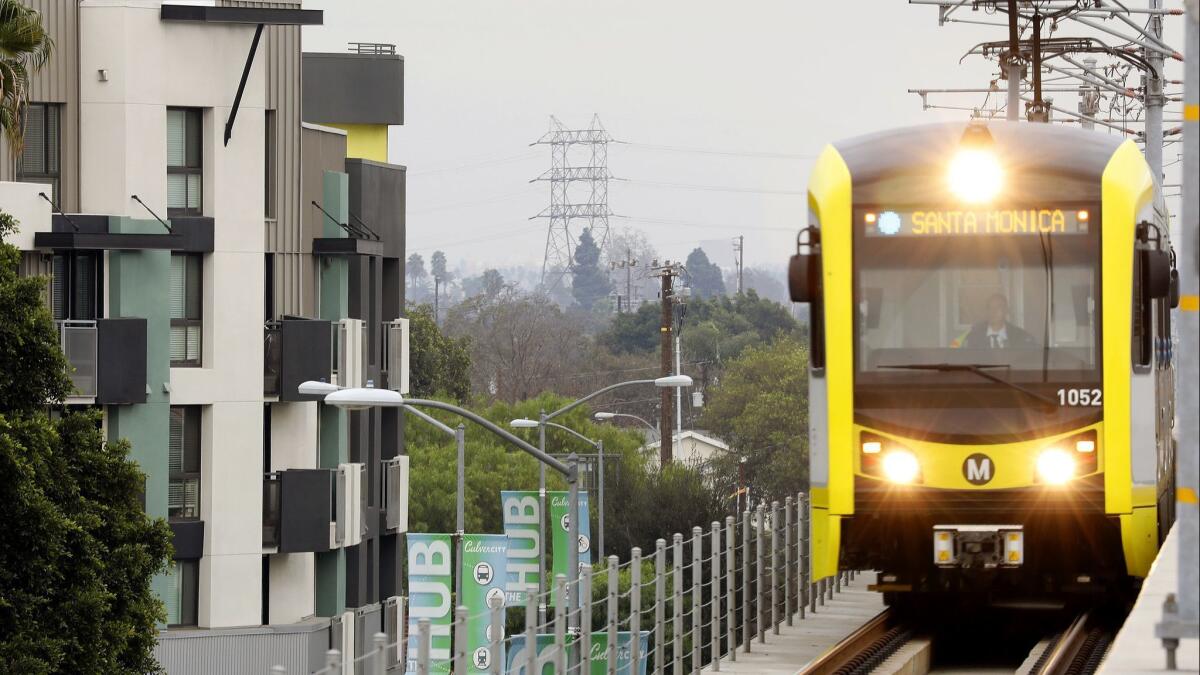Editorial: It’s time for L.A. to put up or shut up about building denser housing around transit

- Share via
When the Los Angeles City Council decided earlier this year to oppose SB 827, a controversial bill in the state Legislature that would have overridden local zoning rules to allow higher density housing near transit stops, council members acknowledged the critical need to build more homes and the wisdom of putting them near public transportation. But the bill went too far, they argued, in wiping out local control and eliminating cities’ power to use planning and zoning to address community needs. Land-use decisions, council members said, should be made at the local level, not Sacramento.
“We as a city need to step up. We need to be engaged and we need to deal with our housing crisis. We have to stop putting it off,” Council President Herb Wesson told his colleagues. “But it is our responsibility.”
Well, here’s their chance.
The City Council will soon vote on the Expo Line Transit Neighborhood Plan, which is the first in a series of “transit neighborhood plans” that rewrite the rules for development in communities directly around rail stations to allow more homes, offices and shops. The plan has sparked opposition among neighborhood groups worried that denser development will worsen traffic and erode community character, so the vote will be a test of the City Council’s commitment to addressing the housing shortage. It’s also an opportunity to show Sacramento that “local control” isn’t code for “no development.”
Enter the Fray: First takes on the news of the minute from L.A. Times Opinion »
Taller, denser, more walkable and more affordable development around transit stations represents the best way to solve two of L.A.’s worst problems — the staggering cost of housing and the crushing toll of traffic. Concentrating new development near rail and bus lines can help reduce Angelenos’ reliance on cars, ease traffic congestion and cut vehicle emissions that are polluting the air and fueling global climate change.
The Expo Line plan was developed over five years with countless meetings and focus groups to get community input. The resulting plan would regulate future development within half a mile of five stops from the Culver City station to the Bundy station. The proposal would allow the development of new residential and commercial properties that could eventually add 14,300 jobs and 6,000 new apartments and condos along the light-rail corridor — depending, of course, on the real estate market. The goal is to make the communities around the stations denser with homes and workplaces and more walkable, so it’s easier for people to get around without a car.
It would let developers build taller projects with more units if they set aside units for low-income residents. The plan also includes design standards, sidewalk improvements and landscaping enhancements to create attractive neighborhoods around the stations.
And, in a rare move for the city, the plan would rezone a single-family neighborhood directly south of the Bundy Station to allow mid-size apartment and town house developments. Single-family communities have typically been off-limits for rezoning and increased density. In fact, one reason SB 827 was so controversial — and ultimately unsuccessful — was that it would have applied to single-family zones and would have opened up low-slung, suburban neighborhoods to apartments and condos.
If Los Angeles leaders are serious about increasing the supply of housing and creating more affordable housing, single-family neighborhoods can’t be sacrosanct. They have to be open to additional housing being built in their midst. This doesn’t mean letting developers bulldoze bungalows and put up skyscrapers. It means loosening restrictions to allow more fourplexes, townhomes and other “missing middle” types of housing in between single-family houses and high-rises.
Los Angeles should be putting housing and workplaces near transit. County taxpayers are spending billions of dollars to build new light-rail, subway and bus lines. It makes sense to cluster new development near those lines to reduce Angelenos’ reliance on their cars. Designing cities to reduce driving is essential because transportation produces half of the state’s greenhouse gas emissions. California will not meet its climate change goals without slashing the number of miles that people drive.
That’s why the Expo Line and other transit neighborhood plans now in development are so important. They offer the opportunity to increase the supply of housing in the right places and to give communities a voice in the process.
L.A. shouldn’t wait for Sacramento to impose higher density zoning. The City Council should pass an aggressively pro-housing Expo Line Transit Neighborhood Plan now.
Follow the Opinion section on Twitter @latimesopinion and Facebook
More to Read
A cure for the common opinion
Get thought-provoking perspectives with our weekly newsletter.
You may occasionally receive promotional content from the Los Angeles Times.









